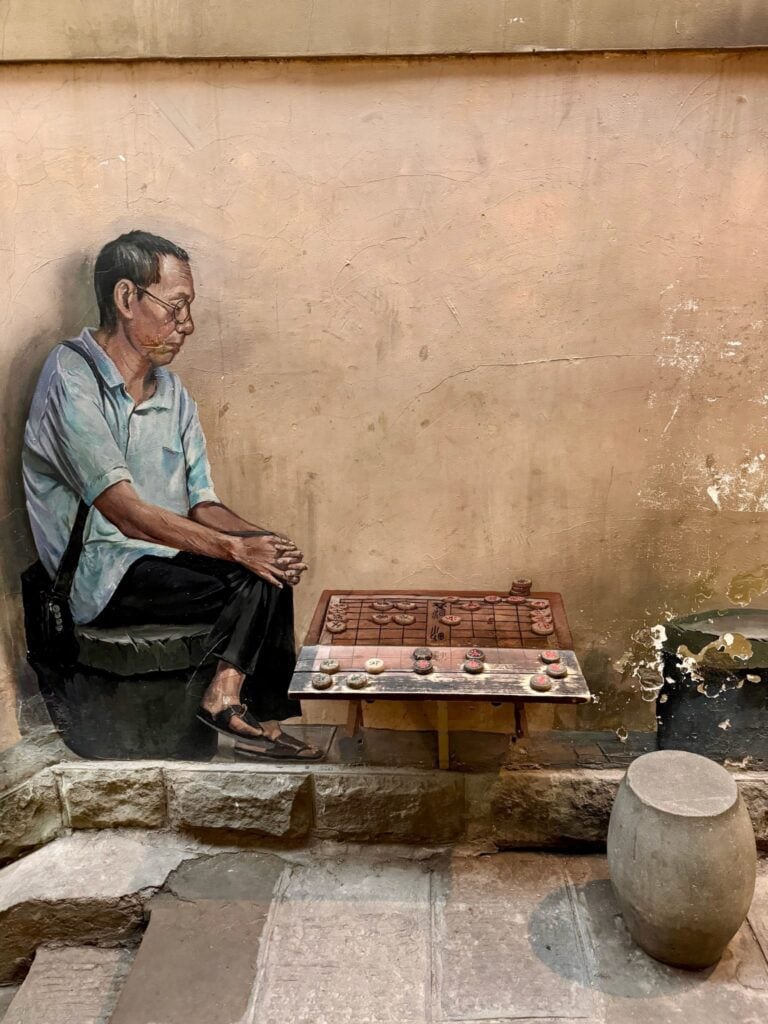Honestly, I think Shibati is one of the most underrated areas in all of Chongqing.
If you love repurposed buildings, perusing through little shops, and getting lost in the nooks and crannies of a historic neighborhood, Shibati is a must-visit.
Once a consulate area and a key link between Chongqing’s upper city and lower city, Shibati (which translates into ‘Eighteen Steps’) was historically a hub of local life. The steep, winding stone steps connected the city’s commercial center to the riverbank below, lined with vendors, craftsmen, and everyday Chongqing residents going about their routines.
In 2015, large parts of Shibati were demolished, leaving ruins behind, but it’s recently been revitalized into a pedestrian-friendly district that blends old and new—restored historic architecture, modern shops, and cultural exhibits all coexisting within its steep, layered layout.
Here’s what you can expect at Shibati these days.


Explore Shibati (Eighteen Steps) The Right Way
We randomly entered “Shibati” into Didi and, by chance, got dropped off at the top of the area—which, as it turns out, is exactly how you should do it.
Shibati literally translates to “Eighteen Steps” or “Eighteen Ladders”, and there are a lot of stairs involved. By starting at the top, you can work your way down instead of exhausting yourself by climbing up the whole time.
At the upper half of the city, you’ll find a few cultural sites, including a historic bell tower, the ruins of an old hospital/elementary school and a welcome center that features a scale model of what the area used to look like before parts of it were demolished.
Before we started heading down, we enjoyed this sweet view of the city.


Exploring the Shops and Cafés
Once we descended a couple flights of stairs, we stumbled upon a super cute plaza filled with old buildings that have been repurposed into lifestyle shops, snack stalls, stationery stores, clothing boutiques, and cafés. It had a relaxed, almost artsy feel to it, and I loved how seamlessly they blended the past with the present.



From there, we made our way to the main drag of the Eighteen Steps area—a hilly pedestrian street (or set of staircases, rather) lined with red and yellow lanterns. It way livelier than the quieter paths we had been wandering through before!
There were lots of people, lots of shops, and plenty of small alleyways branching off from the main staircase.


Cute Finds: Cat Café, Fortune Telling + Street Art
As we ducked into one of these random alleyways, we stumbled upon a cat café called CATSYARD—which was perfect because my mom had been wanting to visit one throughout our entire China trip but hadn’t had the chance.
So, naturally, we pulled the trigger! We spent about 45 minutes playing with a bunch of cute cats before continuing our exploration (they were WAY livelier than the cats at cafes in the USA, so much fun!).
Further down, I found a couple of super neat spots including a secluded courtyard cafe and a beautiful eye-catching set of red walls—seriously, a perfect photo spot!




Nearby, there were some fortune tellers offering readings using small birds that pick out your fortune. My cousin was so intrigued but ultimately chickened out—mostly because he didn’t know how to speak Chinese, and the idea of trying to translate his fate on the spot with the help of my mom was too much for him LOL.
👉 Pro Tip: As you weave through Shibati’s labyrinth of stairs and alleys, keep your eyes peeled for artwork—the area’s street art is amazing! Some of the murals here are among the most creative I’ve seen in China. I particularly loved this mural of two Chinese children playing and this chess one of a weathered man deep in thought about his next move.


Final Thoughts: It’s A Must-Do!
I came into Shibati with zero expectations because there were so few resources available when I was researching my trip. But once I got there, I was completely blown away by how massive and full it was—so much bigger and so much livelier than I had imagined.
As someone who loves exploring aimlessly, I think Shibati deserves at least three hours of your time. I absolutely adored this place, despite the throngs of people we encountered on the main staircase.
There are so many little walkways and stairs that steered me away from the crowds (very few visitors take the time to explore the side alleys, but YOU totally should)!
Start at the top, take your time, and enjoy discovering all the little surprises along the way.
Best Time To Go? We went during the daytime, but a super popular time to go is at night when all the storefronts light up.
Planning Your Trip To China?
Here are some of our other China travel guides to help you plan an incredible trip:
Chongqing
- Where To Stay In Chongqing: 3 Central Areas For Travelers
- An Afternoon In Ciqikou Ancient Town (Chongqing, China)
- 15 Fun Things To Do In Chongqing (Beyond The TikTok Spots)
Chengdu
- 3 Days In Chengdu, China: Pandas, Ancient Streets, and Royal Banquets
- 4 Days In Chengdu, China: An Even Better Itinerary!
- 15 Actually Fun Things To Do In Chengdu: Beyond Pandas And Temples
- Shuyanfu Dinner Show: A Must-Do In Chengdu, China


